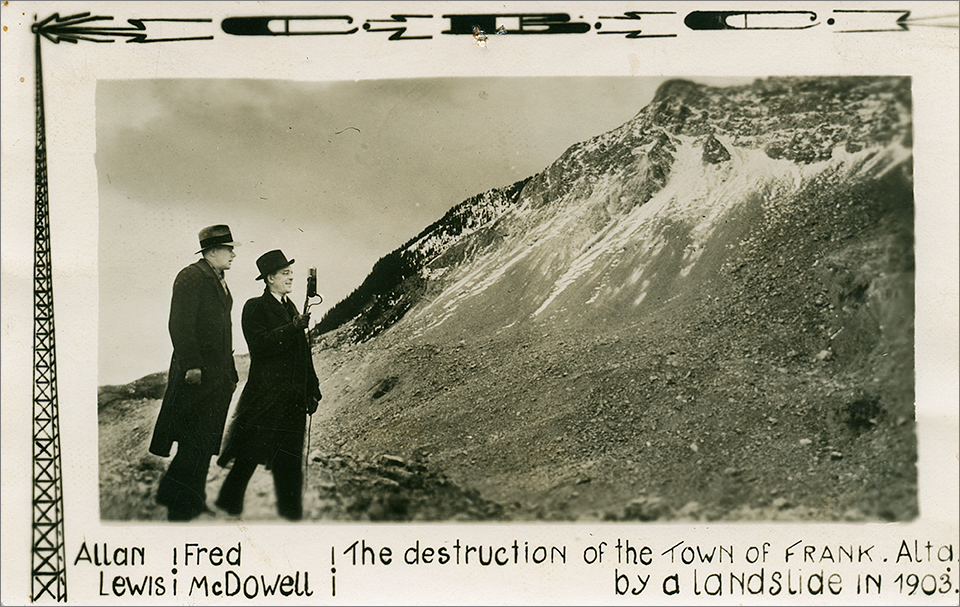
Here’s an interesting photograph that appeared on a postcard, published by the Canadian Broadcasting Corporation (CBC) in 1939. The CBC was still in its infancy then and had only been around three years. The postcard promoted a radio program called Canadian Snapshots. The show aired weekly for two years (1939 – 1940) on the national network. Its announcers were CBC personalities Lorne Greene and J. Frank Willis. Each half-hour episode “turned the lens of the radio camera to the wonders and oddities of Canada.” According to the CBC digital archive website, the program was … “chock full of skits and short dramatic pieces, and augmented with actualities (the relatively new phenomena of onsite reporting). Canadian Snapshots brought the vast panorama of the country to the airwaves to tempt the tourist’s taste.” Crowsnest Pass, and more specifically, the Frank Slide, was highlighted as a Special Events feature on the program. The episode aired 77 years ago today, on November 29, 1939.
The image on the postcard shows a couple of Canadian Snapshots onsite reporters, Allan Lewis and Fred McDowell, standing alongside what today is the Highway 3 viewpoint, overlooking Turtle Mountain and Frank Slide. Both men were radio announcers with CJOC in Lethbridge. One of them, possibly
Fred McDowell, is holding a microphone as if he’s broadcasting live to the nation. It must have been a promotional photo, because the broadcast occurred at the C.P.R. roundhouse in the town of Frank, less than a mile away.
A week later, in the December 8th issue of the Blairmore Enterprise, it mentioned … “Fred McDowell’s very graphic broadcast of the story of the Frank Slide of April 1903, on Wednesday evening of last week, over CBC, was very much enjoyed.” Fred’s father, Sam McDowell, was the local district telephone superintendent for Alberta Government Telephones in nearby Blairmore and was credited with the phone hookup. It goes to show that even in those days it helped if you had connections in the right places!
![]()
![]() I like the graphics on the front of the postcard. There’s an image of a radio tower on the left, with the letters “CBC” streaming across the top, like radio signals transmitting over the airwaves. The caption printed on the front reads, “The destruction of the Town of Frank. Alta. by a landslide in 1903.” When reading this, you would think the entire town was destroyed, when in fact, that’s not the case. It’s a misconception that continues to circulate to this day. Only a small portion of Frank had been affected by the slide, but I suppose it sounds more dramatic this way.
I like the graphics on the front of the postcard. There’s an image of a radio tower on the left, with the letters “CBC” streaming across the top, like radio signals transmitting over the airwaves. The caption printed on the front reads, “The destruction of the Town of Frank. Alta. by a landslide in 1903.” When reading this, you would think the entire town was destroyed, when in fact, that’s not the case. It’s a misconception that continues to circulate to this day. Only a small portion of Frank had been affected by the slide, but I suppose it sounds more dramatic this way.
The postcard was postally used and dated December 15, 1939. It was addressed to a listener in Washington State, who requested the card upon hearing the Frank Slide episode on CBC Radio. On the back is a brief message from someone at the CBC, thanking this person for their interest in the program.
Only six episodes of Canadian Snapshots survive in the CBC archives; all recorded in 1940. Unfortunately, the 1939 Frank Slide segment was not preserved. That’s too bad because it would be interesting to hear what was said at the time about this famous Crowsnest Pass landmark.
It’s unclear why the program only lasted two years. Perhaps its demise was due to the Second World War, which started in September of 1939. Lorne Greene and J. Frank Willis continued their careers with the CBC during the war years.
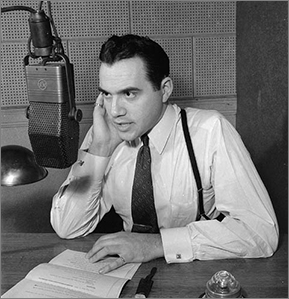
Lorne Greene
Lorne Greene became the principal newsreader and was nicknamed “The Voice of Canada” by the CBC, for his role in delivering news of the war to Canadians. Radio listeners often called him “The Voice of Doom,” because of the way he delivered distressing war news with his deep, booming voice. Those of my generation will likely remember Lorne Greene best in his starring role as the patriarch, Ben Cartwright, in the long-running television series, Bonanza.
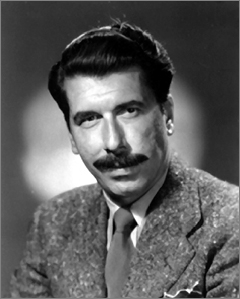
James Francis “Frank” Willis
Frank Willis is regarded as one of the country’s greatest radio reporters. He produced numerous radio programs during WW II, including Nazi Eyes on Canada, where Hollywood actors depicted what North America would be like if the Germans won the war.
Repeating the Photograph
I visited the Highway 3 viewpoint last month to see whether I could replicate the photo of Turtle Mountain that’s on the postcard. It wasn’t too difficult to find the original camera set-up location, and after several attempts, I was able to capture the repeat photo shown below.
Not a lot has changed on the mountain over the years. There are more trees growing in certain places, but otherwise, things look pretty much as they did in 1939. Even the fresh snow covering the upper flanks of Turtle Mountain on the day I photographed closely matches what is seen on the vintage postcard. Click on the photo for a larger view comparing the 1939 image with mine.
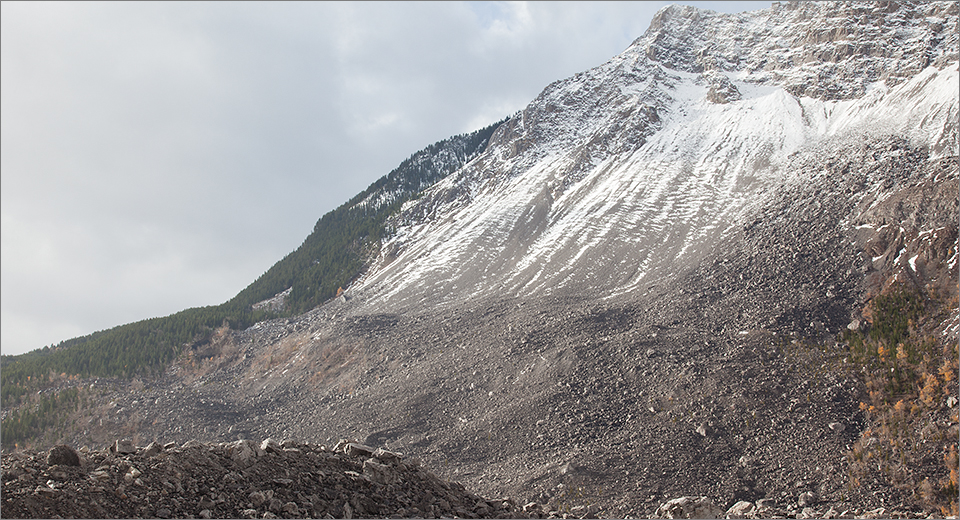
Turtle Mountain and Frank Slide – 2016 Repeat Photo
(click image for larger view comparing 1939 & 2016 images)
If you look carefully at the photograph on the postcard, it’s obvious the reporter’s images were inserted (Photoshopped, as we call it today) into the foreground. This kind of photo manipulation has been done for a long time on all sorts of things, including postcards. Nevertheless, the effect looks realistic and it appears as though the men are actually standing onsite, amid the rock and rubble of Frank Slide.
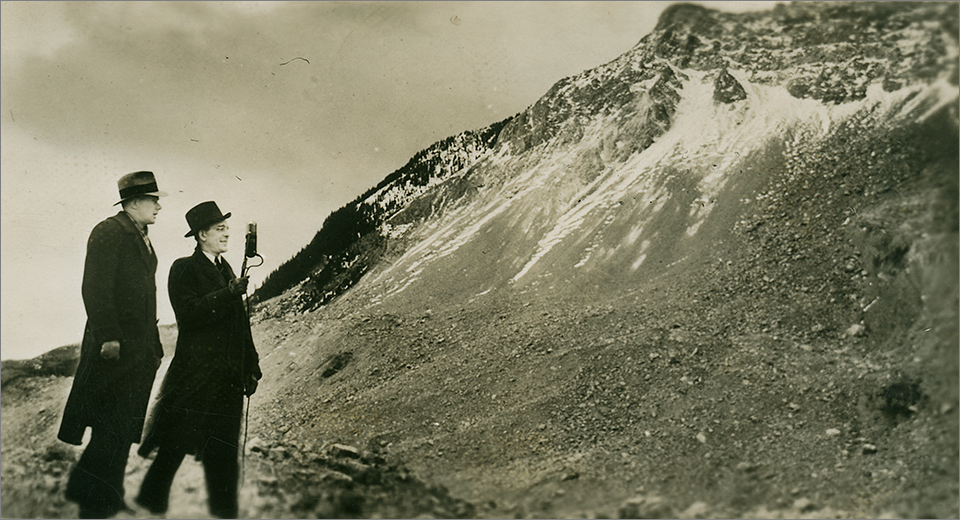
Turtle Mountain and Frank Slide – 1939 Postcard Photo
(click image for larger view comparing 1939 & 2016 images)
There’s no photo credit anywhere on the postcard, indicating who took the pictures of Turtle Mountain and the reporters. I was curious to find out who the photographer was and contacted the Crowsnest Museum to see whether they might have anything in their archives that might help answer this question. It was a long shot but was worth a try.
Chris and Michelle were very helpful at the museum and within a few minutes, they had some answers for me. It turns out the photo was taken by renowned Crowsnest Pass photographer, Thomas Gushul. He is perhaps the best-known photographer to have worked in the Pass and opened his first studio here around 1918. Thomas Gushul passed away in 1962. The Crowsnest Museum is in possession of a large collection of his glass plates and negatives, many of which have been digitized and catalogued. There is also a permanent display on hand, where some of the photography equipment used in the Gushul Studio can be seen.
It didn’t take long for Michelle to bring up the original postcard photograph on her computer monitor. Along with this photo, there were several other images taken by Gushul of the reporters, Allan Lewis and Fred McDowell, at Frank Slide that day in late November, 1939. Thanks to the museum, the identity of the postcard photographer is a mystery no more.
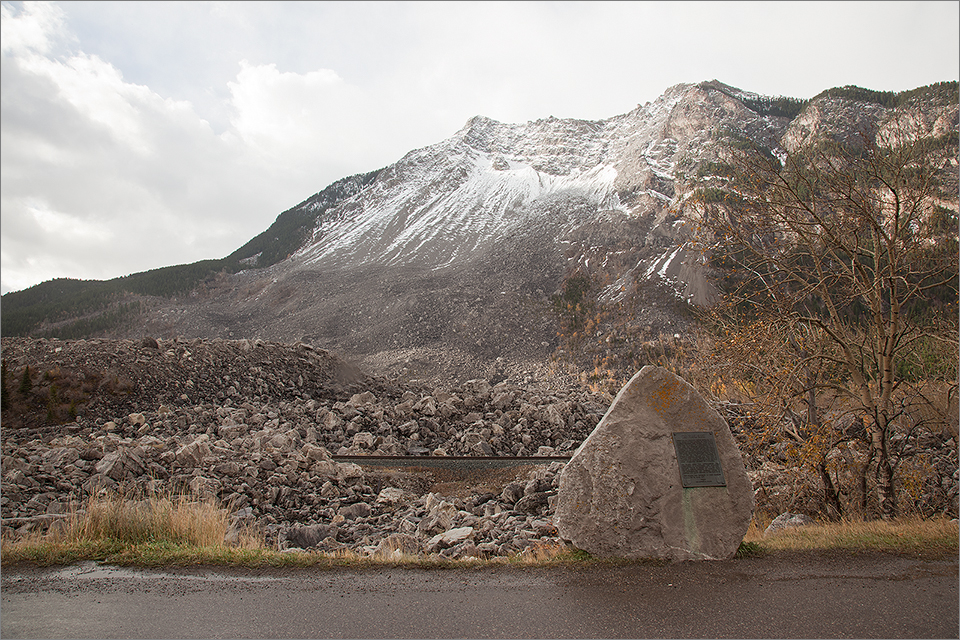
The original postcard photograph was taken by Thomas Gushul from the Hwy. 3 viewpoint, where the large boulder and commemorative plaque are located.
Article References & Credits
CBC Postcard: VB collection
Lorne Greene and J. Frank Willis photos:
Library and Archives Canada (PA-116178)
Canadian Communications Foundation
Crowsnest Museum Archives
CBC Digital Archives
Glenbow Museum Archives
University of Lethbridge Library – Digital Newspaper Archives (Cardston News)
University of Alberta – Peel’s Prairie Provinces (The Blairmore Enterprise)

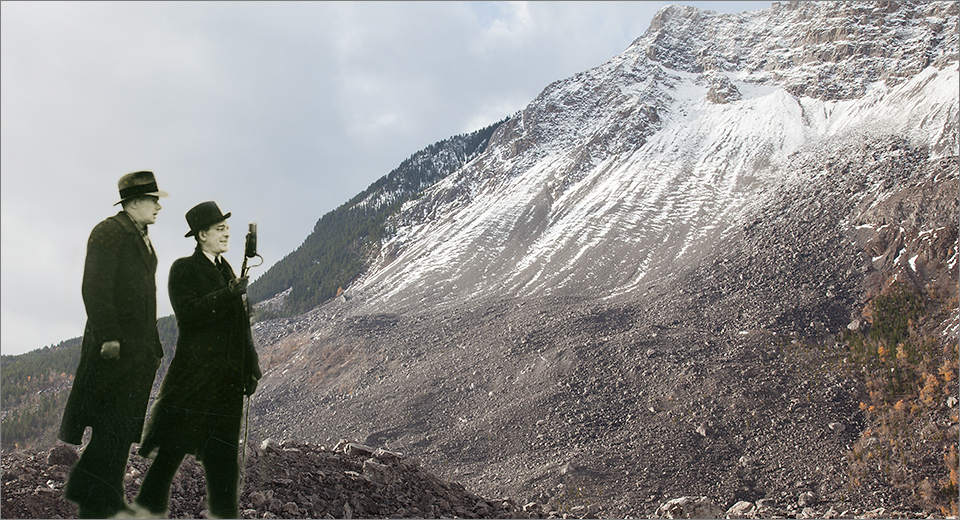
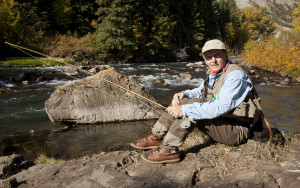
4 Comments
Later studies suggested that the mountain had been at a point of “equilibrium”; even a small deformation such as that caused by the mine’s existence would have helped trigger a slide.
I suspect there was a tipping point in the events leading up to the rockslide and wouldn’t be surprised if the mine’s workings inside Turtle Mountain played a role in what happened. Thanks for commenting.
Great Stuff Vic
John Bucci
MJR Postcards & Covers
John: Thanks for your comment. I know you appreciate old postcards, and I’m glad you like the story.